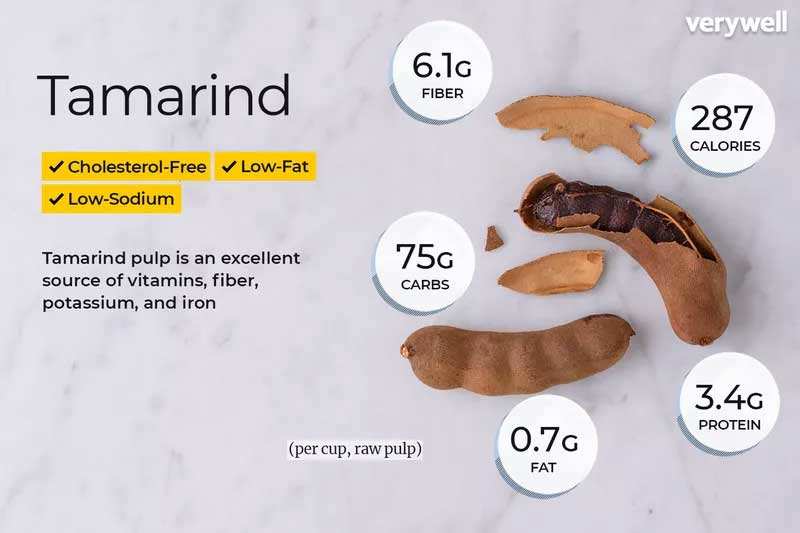
Tamarind pods come from the tamarind tree, which originated in Africa and now grows in many tropical regions. Tamarind is used in Asian, Middle Eastern, Mexican, and South American cuisines.
The sticky pulp of the brown pods has a sweet and sour flavor. It provides tang and acidity to entrees such as pad Thai and to chutneys, desserts, beverages, syrups, sauces, and candy. It is a low-glycemic fruit and contains many beneficial micronutrients, making it a nutritious whole food ingredient.
Tamarind Nutrition Facts
One cup (or 120g) of raw tamarind pulp provides 287 calories, 3.4g protein, 75g carbohydrates, and 0.7g fat. Tamarind is an excellent source of B vitamins and vitamin C, as well as potassium, magnesium, and more minerals. The following nutrition information is provided by the USDA.1
- Calories: 287
- Fat: 0.7g
- Sodium: 34 mg
- Carbohydrates: 75g
- Fiber: 6.1g
- Sugars: 46.6g
- Protein: 3.4g
- Potassium: 754mg
- Vitamin C: 4.2mg
Carbs
While 1 cup of tamarind pulp has 75 grams of carbohydrates (nearly 47 grams of sugar), the fruit’s glycemic load is low, meaning it doesn’t cause blood sugar to spike.2
Pure tamarind usually contains no added sugar or other ingredients, but always be sure to check the label. Tamarind is a popular ingredient in candy, drinks, syrup, and sauces, such as barbecue sauce—all of which often have added sugar.
Fats
Tamarind has a negligible amount of fat, less than 1 gram per 120 grams of pulp.
Protein
Tamarind provides some protein, but not as much as other members of the legume family.
Vitamins and Minerals
Tamarind is an excellent source of B vitamins, vitamin C, potassium, magnesium, iron, thiamine, phosphorus, riboflavin, and fiber.3
Summary
Tamarind is a great source of B vitamins and vitamin C, and is a potassium-rich fruit. Raw tamarind pulp provides carbohydrates and fiber, and minimal amounts of fat and protein.
Health Benefits
Tamarind is a traditional medicine remedy with a long list of uses, including treatment of sore throats, constipation, and sunstroke.4 Animal studies have shown that tamarind may help lower cholesterol5 and blood sugar,6 but no research on humans is available. However, some evidence exists for other health benefits.
Fights Inflammation
Tamarind contains polyphenols, antioxidants that may help control inflammation in the body.47
Relieves Pain
While eating tamarind pulp alone does not offer pain relief, there is evidence that extracts made from many parts of the plant might help with pain.7 For example, one 2013 study found that extracts from tamarind seed could help ease arthritis pain.8
May Support Heart Health
Thanks to its polyphenol, flavonoid, and antioxidant properties, tamarind may help support heart health by preventing oxidative damage caused by LDL cholesterol. A 2013 study found that tamarind may aid in preventing atherosclerosis cardiovascular disease (but this was a lab study; it did not investigate how tamarind might affect human heart health).9
May Improve Liver Function
One of the tamarind fruit’s lesser-known potential health benefits is its ability to improve the function of the liver. A 2011 review explored how the fruit’s procyanidins antioxidants may protect the liver from disease, and discovered a positive effect.10
May Help Fight Cancer
Studies have also linked tamarind’s antioxidant properties to helping fight cancer, specifically renal cell carcinoma. A 2012 study used the fruit’s seed extract and found that its polyphenol compounds both decreased the progress of the cancer and helped prevent it.11
Allergies
Tamarind is a legume and some people will experience an allergic reaction to it. However, if you are allergic to another legume (such as soy), this does not mean that you will also be allergic to tamarind or other legumes.
If you do have a tamarind allergy, read labels carefully, since it can be an ingredient in commercially prepared sauces (like Worcestershire sauce) and other foods. Because it is not one of the eight major allergens, labels do not have to specifically warn that it is present, but it must be included in the ingredient list.12
Adverse Effects
Tamarind pulp can have a laxative effect. Larger amounts are more likely to cause issues.4
Some tamarind candies imported into the U.S. have been found to contain lead (in either the candy or the wrappers). Lead is especially dangerous for children and people who are pregnant, so they should not consume these candies.13
Varieties
Tamarind can be purchased in pod form or as a purée, paste, sauce, concentrate, or block. Many grocery stores stock it, and it can also be found in Indian and Asian markets. You can also order tamarind online, in which case it will most likely ship frozen if in pulp form. Tamarind pastes are usually shelf-stable until opened.
When It’s Best
As the fruit ripens, it becomes less sour and more sweet while the pulp dehydrates slightly and goes from green (unripe) to brown. The pods are easiest to open when the fruit is fully ripe as they become more brittle.
Storage and Food Safety
Store whole tamarind fruit at room temperature and out of direct sunlight or heat. To keep your tamarind fruit and pulp fresh, store it in an airtight container in the refrigerator once opened.
How to Prepare
The simplest way to enjoy tamarind is in the pod form. Break off the brown outer pod and remove the stringy part that looks like a small root wrapped around the pulp. You will be left with a long piece of pulp that has rock-hard seeds inside the size of large corn niblets. Cut it into sections and eat, nibble around the seeds and spit them out.
For cooking, it may be easier to purchase tamarind pulp or paste. It pairs very well with spices, such as curry, ginger, and red pepper, in sauces, marinades, and salad dressings.
Sources:
- Tamarinds, raw. FoodData Central. U.S Department of Agriculture. Published April 1, 2019.
- Uchôa Passos T, Alves de Carvalho Sampaio H, Dantas Sabry MO, Pereira de Melo ML, Magalhães Coelho MA, de Oliveira Lima JW. Glycemic index and glycemic load of tropical fruits and the potential risk for chronic diseases. Food Sci Technol (Campinas). 2014;36(1):66-73. doi:10.1590/1678-457X.6449
- Ebifa-Othieno E, Mugisha A, Nyeko P, Kabasa JD. Knowledge, attitudes and practices in tamarind (Tamarindus indica L) use and conservation in Eastern Uganda. J Ethnobiol Ethnomed. 2017;13(1):5. doi:10.1186/s13002-016-0133-8
- Bhadoriya SS, Ganeshpurkar A, Narwaria J, Rai G, Jain AP. Tamarindus indica: Extent of explored potential. Pharmacogn Rev. 2011;5(9):73-81. doi:10.4103/0973-7847.79102
- Lim CY, Mat junit S, Abdulla MA, Abdul Aziz A. In vivo biochemical and gene expression analyses of the antioxidant activities and hypocholesterolaemic properties of Tamarindus indica fruit pulp extract. PLoS ONE. 2013;8(7):e70058. doi:10.1371/journal.pone.0070058
- Sole, SS, Srinivasan BP, Akarte AS. Anti-inflammatory action of Tamarind seeds reduces hyperglycemic excursion by repressing pancreatic β-cell damage and normalizing SREBP-1c concentration. Pharm Biol. 2013;51(3):350-60. doi:10.3109/13880209.2012.729067
- Komakech R, Kim YG, Matsabisa GM, Kang Y. Anti-inflammatory and analgesic potential of Tamarindus indica Linn. (Fabaceae): A narrative review. Integr Med Res. 2019;8(3):181-186. doi:10.1016/j.imr.2019.07.002
- Hivrale MG, Bandawane DD, Mali AA. Anti-inflammatory and analgesic activities of petroleum ether and ethyl acetate fractions of Tamarindus indica seeds. Orient Pharm Exp Med. 2013;13:319–326. doi:10.1007/s13596-013-0116-4
- Lim CY, Junit SM, Abdulla MA, Aziz AA. In vivo biochemical and gene expression analyses of the antioxidant activities and hypocholesterolaemic properties of tamarindus indica fruit pulp extract. PLOS ONE. 2013;8(7):e70058. doi:10.1371/journal.pone.0070058
- Bhadoriya SS, Ganeshpurkar A, Narwaria J, Rai G, Jain AP. Tamarindus indica: Extent of explored potential. Pharmacogn Rev. 2011;5(9):73-81. doi:10.4103/0973-7847.79102
- Vargas-Olvera CY, Sánchez-González DJ, Solano JD, et al. Characterization of N-diethylnitrosamine-initiated and ferric nitrilotriacetate-promoted renal cell carcinoma experimental model and effect of a tamarind seed extract against acute nephrotoxicity and carcinogenesis. Mol Cell Biochem. 2012;369(1):105-117. doi:10.1007/s11010-012-1373-0
- US Food and Drug Administration. Food Allergen Labeling and Consumer Protection Act of 2004 questions and answers. Updated July 16, 2018.
- Centers for Disease Control and Prevention. Lead in foods, cosmetics, and medicine. Updated July 30, 2019.
Important Notice: This article was originally published at www.verywellfit.com by Elizabeth Woolley where all credits are due. Medically reviewed by Mia Syn, MS, RDN.
Disclaimer
The watching, interacting, and participation of any kind with anything on this page does not constitute or initiate a doctor-patient relationship with Dr. Farrah®. None of the statements here have been evaluated by the Food and Drug Administration (FDA). The products of Dr. Farrah® are not intended to diagnose, treat, cure, or prevent any disease. The information being provided should only be considered for education and entertainment purposes only. If you feel that anything you see or hear may be of value to you on this page or on any other medium of any kind associated with, showing, or quoting anything relating to Dr. Farrah® in any way at any time, you are encouraged to and agree to consult with a licensed healthcare professional in your area to discuss it. If you feel that you’re having a healthcare emergency, seek medical attention immediately. The views expressed here are simply either the views and opinions of Dr. Farrah® or others appearing and are protected under the first amendment.
Dr. Farrah® is a highly experienced Licensed Medical Doctor certified in evidence-based clinical nutrition, not some enthusiast, formulator, or medium promoting the wild and unrestrained use of nutrition products for health issues without clinical experience and scientific evidence of therapeutic benefit. Dr. Farrah® has personally and keenly studied everything she recommends, and more importantly, she’s closely observed the reactions and results in a clinical setting countless times over the course of her career involving the treatment of over 150,000 patients.
Dr. Farrah® promotes evidence-based natural approaches to health, which means integrating her individual scientific and clinical expertise with the best available external clinical evidence from systematic research. By individual clinical expertise, I refer to the proficiency and judgment that individual clinicians acquire through clinical experience and clinical practice.
Dr. Farrah® does not make any representation or warranties with respect to the accuracy, applicability, fitness, or completeness of any multimedia content provided. Dr. Farrah® does not warrant the performance, effectiveness, or applicability of any sites listed, linked, or referenced to, in, or by any multimedia content.
To be clear, the multimedia content is not intended to be a substitute for professional medical advice, diagnosis, or treatment. Always seek the advice of your physician or other qualified health providers with any questions you may have regarding a medical condition. Never disregard professional medical advice or delay in seeking it because of something you have read or seen in any website, video, image, or media of any kind. Dr. Farrah® hereby disclaims any and all liability to any party for any direct, indirect, implied, punitive, special, incidental, or other consequential damages arising directly or indirectly from any use of the content, which is provided as is, and without warranties.








